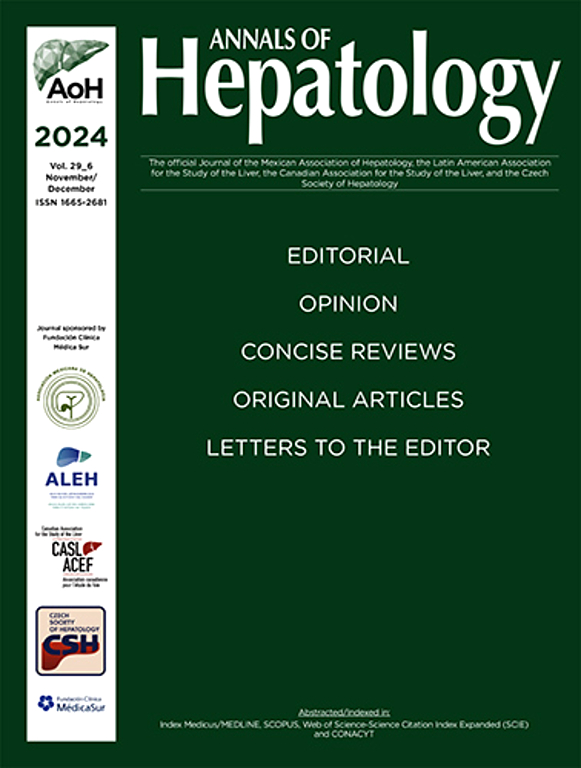Seroprevalence of hepatitis b and c viruses in blood donors in a third level hospital from 2019 to 2023.
IF 3.7
3区 医学
Q2 GASTROENTEROLOGY & HEPATOLOGY
引用次数: 0
Abstract
Introduction and Objectives
Hepatitis B virus (HBV) and C virus (HCV) infection are public health problems and risks for transfusion medicine, which have been reduced by routine serological screening. The aim of this work is to describe the prevalence of these infections in blood donors in a tertiary hospital.
Materials and Patients
An observational, descriptive, retrospective and analytical study was conducted from 2019 to 2023 in blood donors in a third-level hospital, a total of 99,393 donors; only the complete records of the donors who resulted with reactivity and later confirmation for HBV and HCV were reviewed, The data were analyzed using the Statistical Program SPSS. Qualitative variables are expressed as percentages and quantitative variables as mean±SD, as appropriate.
Results
A total of 370 donors who tested positive for some virus were included, despite having been classified as suitable to donate blood products following an official questionnaire with no relevant history and laboratory tests with no alterations. The mean age was 42.02±11.88 years; 54% were men; 135 patients were reactive for HBV and 235 for HCV; however, the true seropositivity found was 2 (1.4%) cases with HBV and 11 (4.6%) cases for HCV (figure 1); the rest of the donors with reactive serology had negative confirmatory studies. The overall seroprevalence observed in our population was 0.002% for HBV, 100% for men and, 0.011% for HCV, 45.4% for women and 54.4% for men. The frequency was 5.5 times higher for HCV than for HBV.
Conclusions
In people with no apparent risk factors, the prevalence of HBV and HCV infection is very low, with HCV being more frequent. However, if the “fit” is infected, it is necessary to optimize the health system to offer universal screening that includes those with risk factors.
2019 - 2023年某三甲医院献血者乙型和丙型肝炎病毒血清阳性率
乙型肝炎病毒(HBV)和丙型肝炎病毒(HCV)感染是公共卫生问题和输血药物的风险,通过常规血清学筛查已经降低了这一风险。这项工作的目的是描述这些感染的流行在献血者在三级医院。材料与患者:2019 - 2023年对某三级医院献血者进行观察性、描述性、回顾性和分析性研究,共99393名献血者;仅对出现HBV和HCV阳性反应的献血者的完整记录进行回顾,并使用SPSS统计程序对数据进行分析。定性变量用百分比表示,定量变量视情况用mean±SD表示。结果共有370名献血者被纳入,他们在没有相关病史的官方调查问卷和没有改变的实验室检查后被归类为适合献血者。平均年龄42.02±11.88岁;54%为男性;135例HBV阳性,235例HCV阳性;然而,发现的真正血清阳性HBV为2例(1.4%),HCV为11例(4.6%)(图1);其余血清学反应的献血者证实性研究阴性。在我们的人群中观察到的总体血清阳性率为HBV为0.002%,男性为100%,HCV为0.011%,女性为45.4%,男性为54.4%。HCV的发病频率是HBV的5.5倍。结论在无明显危险因素的人群中,HBV和HCV感染率极低,以HCV感染率较高。然而,如果“适合者”被感染,则有必要优化卫生系统,提供包括具有危险因素的人在内的普遍筛查。
本文章由计算机程序翻译,如有差异,请以英文原文为准。
求助全文
约1分钟内获得全文
求助全文
来源期刊

Annals of hepatology
医学-胃肠肝病学
CiteScore
7.90
自引率
2.60%
发文量
183
审稿时长
4-8 weeks
期刊介绍:
Annals of Hepatology publishes original research on the biology and diseases of the liver in both humans and experimental models. Contributions may be submitted as regular articles. The journal also publishes concise reviews of both basic and clinical topics.
 求助内容:
求助内容: 应助结果提醒方式:
应助结果提醒方式:


